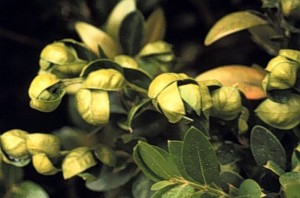
Boxwoods are wonderful shrubs that can be shaped into interesting and sometimes intricate hedges, but they hold little interest on their own and should be monitored for pests.
Landscape designers have made the most out of the boxwood to create deer resistant gardens, but in doing so have encouraged other pests to proliferate. When everyone in the county is planting the same plant, we create a monoculture, and that is the heart of the problem. Deer may not care for boxwoods, but there are a few insects that LOVE them and we have invited them to a bountiful buffet. (More on how to recognize and treat this and other infestations on page 2.)
BOXWOOD LEAF MINER • The adult leaf miner looks like a mosquito. In May and June multitudes can be seen bobbing up and down on boxwood hedges moving from leaf to leaf laying eggs. By late winter the larvae have emerged from the eggs and begin eating, or mining out, the inside of the boxwood leaf. On a quiet day in early spring, if you put your ear near an infested boxwood you may hear what sounds like Rice KrispiesTM in milk as these orange worms munch their way through the inside of the leaves. By spring the leaves of the boxwoods are sickly and have yellow spots.
If boxwood leaf miner is not controlled, the population will expand until nearly every leaf in a plant or hedge is infested with one or more of these destructive larvae.
Fortunately, there is a treatment that can prevent serious damage. Because the larvae live inside the leaf, topical sprays will not reach the insects. A systemic insecticide, such as imidacloprid, applied in early spring will go inside the vascular system of the plant and kill the insect as it feeds.
PSYLLID INFESTATION • Another major insect problem for boxwoods is psyllid. This tiny insect damages the newly developing foliage causing “cupping” of the leaves. These distorted leaves provide cover for the insect while it matures. This damage does not threaten the health of the plant, but if enough leaves become cupped it can detract from your garden design. Boxwood psyllid can also be controlled by imidacloprid or by spraying horticultural oil in the early spring before the new leaves develop.
SPIDER MITES • Spider mites will also feed on boxwood, especially in hot summer months. As they feed the foliage yellows, resulting in a blanched look to the plant. You may also find webbing on the foliage or interior of the plant. Mites are not insects and will not be controlled with insecticides. The best control is horticultural oil, but a miticide can be used for severe outbreaks.
WINTER INJURY • Boxwoods are highly susceptible to winter injury. This happens when they are exposed to severe cold temperatures or sudden warm or windy days in late winter. This causes transpiration of the moisture out of the plant when there is no replacement fluid coming from the soil. An application of an anti-transpirant in the fall allows you to enjoy the beauty of your landscape while reducing the drying and winter burn. Alternatively, you can wrap them in burlap to prevent
winter injury.
_________
For answers to gardening questions, contact me via email: sean@reddingnursery.com
© 2013 Redding Nursery,
all rights reserved.



Recent Comments